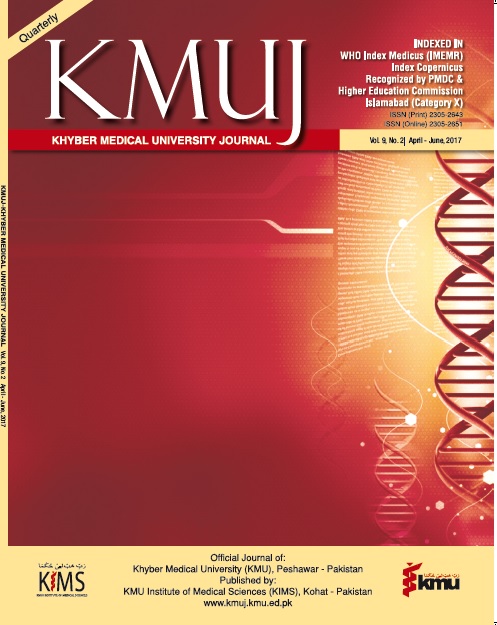IRON DEFICIENCY STATUS IN FIRST TIME, REPLACEMENT, VOLUNTARY AND REGULAR MALE BLOOD DONORS AT TERTIARY CARE HOSPITALS OF PESHAWAR, PAKISTAN
Main Article Content
Abstract
ABSTRACT
OBJECTIVE: to determine iron deficiency in first time, replacement, voluntary and regular male blood donors and to detect pre-clinical iron deficiency in blood donors at tertiary care hospitals of Peshawar, Pakistan by assessing serum ferritin levels.
METHODS: In this cross-sectional descriptive study 152 male blood donors from North West General Hospital and Hayatabad Medical Complex, Peshawar, Pakistan were recruited from 1st December, 2012 to 30th May, 2013. Donors were divided into regular and non-regular (1st time, replacement and voluntary) groups based on number of donations in the past. Quantitative determination of serum ferritin levels was performed by Chemiluminescence immunoassay. Serum ferritin level >30µg/L were taken as normal, 15-30µg/L were reduced and <15µg/L were iron deficiency. Data was analyzed using descriptive statistics in SPSS version 20.
RESULTS: Out of 23 regular donors, 17 (73.9%) while out of 129 non regular donors, 13 (10.1%) developed iron deficiency. The mean number of donations for all donors was 2.8+2.6 (range 0-20). Among non-regular blood donors, 09% 1st time donors, 9.3% replacement donors and 15.8% voluntary donors had iron deficiency. Iron deficiency was recorded in 19.7% of the whole study sample. Statistically significant inverse relationship existed between number of donations and serum ferritin levels (r=-0.193, p 0.017). Also a weak positive relationship between time since last donation (months) and serum ferritin levels (r=0.109, p 0.18).
CONCLUSION: Regular blood donation in males causes serious iron deficiency. Pre-donation serum ferritin analysis identifies and prevents iron deficiency in both regular and non-regular blood donors.
KEY WORDS:
Blood Donors (MeSH), Anemia (MeSH), Ferritins (MeSH), Iron (MeSH)
Article Details
Work published in KMUJ is licensed under a
Creative Commons Attribution 4.0 License
Authors are permitted and encouraged to post their work online (e.g., in institutional repositories or on their website) prior to and during the submission process, as it can lead to productive exchanges, as well as earlier and greater citation of published work.
(e.g., in institutional repositories or on their website) prior to and during the submission process, as it can lead to productive exchanges, as well as earlier and greater citation of published work.
References
REFERENCES
Boulton F. Managing donors and iron deficiency. Vox Sang 2004;87(s2):22-4.
Bryant BJ, Yau YY, Arceo SM, Daniel‐Johnson J, Hopkins JA, Leitman SF. Iron replacement therapy in the routine management of blood donors. Transfusion 2012;52(7):1566-75.
Jeremiah ZA, Koate BB. Anaemia, iron deficiency and iron deficiency anaemia among blood donors in Port Harcourt, Nigeria. Blood Transfus 2010;8(2):113.
Cable RG, Glynn SA, Kiss JE, Mast AE, Steele WR, Murphy EL, et al. Iron deficiency in blood donors: the REDS-II Donor Iron Status Evaluation (RISE) study. Transfusion 2012;52(4):702-11.
Schotten N, Pasker-de Jong PC, Moretti D, Zimmermann MB, Geurts-Moespot AJ, Swinkels DW, et al. The donation interval of 56 days requires extension to 180 days for whole blood donors to recover from changes in iron metabolism. Blood 2016;128(17):2185-8.
Radtke H, Meyer T, Kalus U, Rocker L, Salama A, Kiesewetter H, et al. Rapid identification of iron deficiency in blood donors with red cell indexes provided by Advia 120. Transfusion 2005;45(1):5-10.
Cançado RD, Langhi Junior D. Blood donation, blood supply, iron deficiency and anemia: it is time to shift attention back to donor health. Rev Bras Hematol Hemoter 2012;34(5):330-1.
Mittal R, Marwaha N, Basu S, Mohan H, Kumar AR. Evaluation of iron stores in blood donors by serum ferritin. Indian J Med Res 2006;124(6):641.
Nadarajan V, Sthaneshwar P, Eow G. Use of red blood cell indices for the identification of iron deficiency among blood donors. Transfus Med 2008;18(3):184-9.
Abdullah SM. The effect of repeated blood donations on the iron status of male Saudi blood donors. Blood Transfus 2011;9(2):167.
Røsvik A, Ulvik R, Wentzel-Larsen T, Hervig T. The effect of blood donation frequency on iron status. Transfus Apher Sci 2009;41(3):165-9.
Alvarez-Ossorio L, Kirchner H, Kluter H, Schlenke P. Low ferritin levels indicate the need for iron supplementation: strategy to minimize iron-depletion in regular blood donors. Transfus Med 2000;10(2):107-12.
World Health Organizations. Assessing the iron status of populations: including literature reviews: report of a Joint World Health Organization. Centers for Disease Control and Prevention Technical Consultation on the Assessment of Iron Status at the Population Level, Geneva, Switzerland. 2004:6-8.
Centers for Disease Control and Prevention (CDC). Iron deficiency--United States, 1999-2000. MMWR 2002;51(40):897.
World Helath Organizations. Iron deficiency anaemia: assessment, prevention and control: a guide for programme managers. 2001. [Cited on Januray 28, 2017.] Available from URL: http://apps.who.int/iris/bitstream/10665/66914/1/WHO_NHD_01.3.pdf
Kalantar-Zadeh K, Rodriguez RA, Humphreys MH. Association between serum ferritin and measures of inflammation, nutrition and iron in haemodialysis patients. Nephrol Dial Transplant 2004;19(1):141-9.
Van Vranken M. Evaluation of microcytosis. Am Fam Physician 2010;82(9):1117-22.
Mozaheb Z, Khayami M, Sayadpoor D. Iron balance in regular blood donors. Transfus Med Hemother 2011;38(3):190-4.
Lee C, Wong H, Hong J, Leung J, Tsoi W, Lin C. A study of the predonation hemoglobin and iron status among Hong Kong Chinese blood donors. Transfusion 2013;53(2):322-7.
Badar A, Ahmed A, Ayub M, Ansari AK. Effect of frequent blood donations on iron stores of non anaemic male blood donors. J Ayub Med Coll Abbottabad 2002;14(2):24-7.
Yousefinejad V, Darvishi N, Arabzadeh M, Soori M, Magsudlu M, Shafiayan M. The evaluation of iron deficiency and anemia in male blood donors with other related factors. Asian J Transfus Sci 2010;4(2):123.
